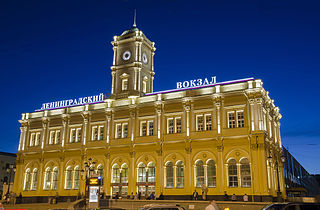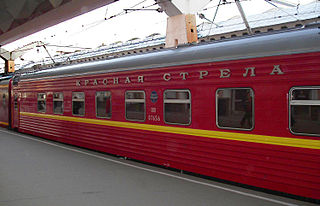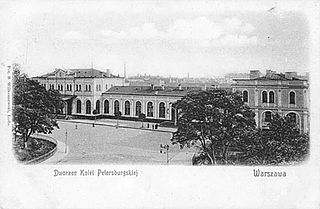| |||||
| Decades: | |||||
|---|---|---|---|---|---|
| See also: | |||||
Events from the year 1851 in Russia
| |||||
| Decades: | |||||
|---|---|---|---|---|---|
| See also: | |||||
Events from the year 1851 in Russia
| | This section needs expansion. You can help by adding to it. (October 2015) |
| | This section needs expansion. You can help by adding to it. (October 2015) |
| | This section needs expansion. You can help by adding to it. (October 2015) |

Konstantin Andreyevich Thon, also spelled Ton was an official architect of Imperial Russia during the reign of Nicholas I. His major works include the Cathedral of Christ the Saviour, the Grand Kremlin Palace and the Kremlin Armoury in Moscow.

The Saint Petersburg to Moscow railway runs for 649.7 kilometers (403.7 mi) through four oblasts: Leningrad, Novgorod, Tver and Moscow. It is a major traffic artery in the north-west region of Russia, operated by the October Railway subdivision of Russian Railways.

Moscow Leningradsky railway terminal also known as Moscow Passazhirskaya station is the oldest of Moscow's nine railway terminals. Situated on Komsomolskaya Square, the station serves north-western directions, notably Saint Petersburg. International services from the station include Tallinn, Estonia, operated by GoRail, and Helsinki, Finland.

Komsomolskaya Square, known as Kalanchyovskaya before 1932, is a square in Moscow, with a blend of revivalist Tsarist and Stalinist architecture. It is referred to informally as Three Station Square after the three rail termini situated there: Leningradsky, Yaroslavsky, and Kazansky. These stations connect Moscow with Saint Petersburg, northwestern Russia, the Volga region, and Siberia via the Trans-Siberian Railway.

St. Petersburg–Glavny, is a railway station terminal in Saint Petersburg, Russia. It is a terminus for the Saint Petersburg–Moscow Railway and other lines running from Central and South Russia, Crimea, Siberia and Eastern Ukraine.

Varshavsky station, or Warsaw station, is a former passenger railway station in Saint Petersburg, Russia. It is located to the south of the city centre, and was in operation from 1853 to 2001 From 2001 to 2017 it served as the home of the Russian Railway Museum.

Kursky railway terminal, also known as Moscow Kurskaya railway station, is one of the ten railway terminals in Moscow. It was built in 1896, and renovated in 1938, then a large glass facade and modern roof was added in a 1972 expansion. In 2008, there were plans to completely rebuild or refurbish the station. Kursky station, unlike most Moscow terminals, operates two almost opposite railroad directions from Moscow: one toward Kursk, Russia, after which the station is named, that stretches on into Ukraine, and another toward Nizhniy Novgorod, which is less used by long-distance trains, and is mostly for the high-speed service to Nizhniy. Kursky is connected to the Lengradskiy Line from the other side, enabling long-distance trains from St. Petersburg going on to other cities to pass through Russia's capital. Because of its three directions, its adjacency to the city center, and its connection to three major metro lines, Kursky is one of Moscow's busiest railway stations.

The Russian Revival style is a number of different movements within Russian architecture that arose in the second quarter of the 19th century and was an eclectic melding of Byzantine elements and pre-Petrine architecture.

Uglovka is an urban locality in Okulovsky District of Novgorod Oblast, Russia, located on the Moscow – Saint Petersburg Railway. Municipally, it is incorporated as Uglovskoye Urban Settlement in Okulovsky Municipal District, one of the three urban settlements in the district. Population: 3,064 (2010 Census); 3,553 (2002 Census); 4,041 (1989 Census).

The Riihimäki–Saint Petersburg railway is a 385-kilometre (239 mi) long segment of the Helsinki–Saint Petersburg connection, which is divided between Saint Petersburg and Leningrad Oblast in Russia and the province of Southern Finland in Finland.

Oktyabrskaya Railway or October Railway is the subsidiary of RZD, servicing railway lines in the north-west of Russia. It stretches from Moscow's Leningrad Terminal in the south to Murmansk beyond the Arctic Circle in the north. The total length of the lines is over 10,000 km. The headquarters are located in Saint Petersburg.

St. Petersburg is a major trade gateway, financial and industrial center of Russia specialising in oil and gas trade, shipbuilding yards, aerospace industry, radio and electronics, software and computers; machine building, heavy machinery and transport, including tanks and other military equipment, mining, instrument manufacture, ferrous and nonferrous metallurgy, chemicals, pharmaceuticals, medical equipment, publishing and printing, food and catering, wholesale and retail, textile and apparel industries, and many other businesses.

Lanskaya railway station is a railway station in St. Petersburg, Russia located between Serdobolskaya street and Bolshoi Sampsonievsky street. It was named after the historical district of Saint Petersburg.

The Russian steam locomotive class O was an early type of Russian steam locomotives. 9,129 locomotives were built between 1890 and 1928; hence it was the second most numerous class of locomotive in Russia, after E class, which was a unique number even on the international level.

The Sapsan is a Russian gauge high speed electric express train. The train is a Siemens Velaro model, which in turn is based on the ICE 3M/F high-speed trains manufactured by Siemens for the German Deutsche Bahn (DB), known as the Siemens Velaro RUS.

The Red Arrow is a Russian overnight sleeper train connecting Moscow and Saint Petersburg via the Moscow–Saint Petersburg Railway.

Saint Petersburg–Warsaw Railway is a 1,333 km (828 mi) long railway, built in the 19th century by the Russian Empire to connect Russia with Central Europe. At the time the entire railway was within the Russian Empire: Warsaw was under a Russian partition of Poland. Due to territorial changes, the line now lies within five countries and crosses the eastern border of the European Union three times. Therefore, no passenger trains follow the entire route. Passenger trains between Saint Petersburg and Warsaw used to travel through Brest instead and a new line called Rail Baltica is under development to improve the direct connection between Poland and Lithuania.

Saint Petersburg, formerly known as Petrograd (1914–1924) and later Leningrad, is the second-largest city in Russia after Moscow. It is situated on the Neva River, at the head of the Gulf of Finland on the Baltic Sea. The city had a population of roughly 5.6 million residents as of 2021. Saint Petersburg is the fourth-most populous city in Europe, the most populous city on the Baltic Sea, and the world's northernmost city of more than 1 million residents. As Russia's Imperial capital, and a historically strategic port, it is governed as a federal city.

The Leningradsky suburban railway line is one of eleven railway lines used for suburban railway connections between Moscow, Russia, and surrounding areas in Moscow Oblast and Tver Oblast. The Leningradsky suburban railway line connects Moscow with the station in the northwest, in particular, with the towns of Khimki, Zelenograd, Solnechnogorsk, Klin, Konakovo, and Tver. The stations the direction serves are located in Moscow, in the towns of Khimki, Solnechnogorsk, and Klin in Moscow Oblast, and in Konakovsky and Kalininsky Districts and the city of Tver of Tver Oblast. The suburban trains have their southeastern terminus at Moscow Leningradsky railway station in Moscow. In the northwestern direction, the suburban trains terminate at Kryukovo, Podsolnechnaya, Klin, Konakovo GRES, and Tver. The line is served by October Railway. This is in contrast to all other suburban directions from Moscow, which are served by Moscow Railway.
Events from the year 1862 in Russia.
![]() Media related to 1851 in Russia at Wikimedia Commons
Media related to 1851 in Russia at Wikimedia Commons